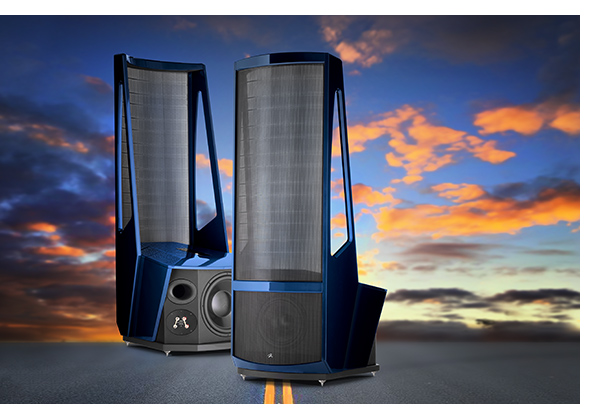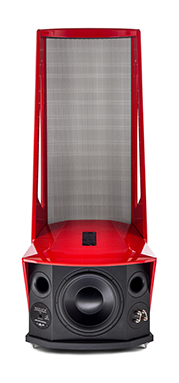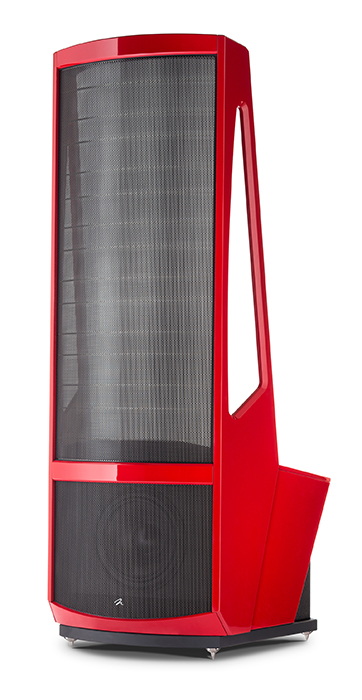Scaling The Mighty Neolith The Top of the MartinLogan Mountain
By Jeff Dorgay The good news is that after years of refinement, MartinLogan has nailed the integration of ESL panel and dynamic woofer to a level they have never done.
The good news is that after years of refinement, MartinLogan has nailed the integration of ESL panel and dynamic woofer to a level they have never done.
I’ve owned nearly every version of ML speaker over the last 25 years and have loved them all. But these take the concept to perfection. Three minutes into the classic Robert Plant track “Sixes and Sevens,” there’s a tiny bell that sounds like a manual typewriter return and it hangs in space, crystal clear in a way that this well-worn classic rock track has never done. Even a fairly dense recording, like TV on the Radio’s Dear Science is unlocked, revealing a plethora of new information. That’s what you spend the big money on a pair of speakers for – and these are big money. Just a few nickels shy of $80k.
Turning the volume control on the Pass Xs Pre further clockwise, closing my eyes and staying in that vein, a 45 rpm maxi single of AC/DC’s “For Those About to Rock” pegs the meters on the Xs300 power amplifiers and I’m transported back to the front row of Milwaukee’s Auditorium. The cannons blast, without the usual clipping and compression that plagues most systems I’ve heard, and it’s 1981 again.
Other speakers I’ve been listening to sound small in comparison. You wouldn’t think anything this big could possibly disappear in the room, yet these monstrous speakers completely vanish. Even with the lights on, they just fade out of view. The Neoliths don’t just deliver holographic imaging, they turn your listening room into the holodeck. Where most other ESLs (some past ML models included) generate a luscious musical rendition, albeit with a small optimal listening spot, you can stretch out with the Neolith. Not only do they produce a couch-wide listening sweet spot, they sound pretty damn good when you’re just sitting down on the floor or off somewhere to the side. This doesn’t happen with any other ESL, period.
You might think an $80 thousand pair of speakers would do everything, and on many levels the Neoliths do. But just like the world’s most exotic cars, the mega speakers all have different personalities, some with greater strengths than others. Having spent a few years with the CLX as a reference speaker and reveling in its glory, it still did not represent mega speaker status to me. When set up to perfection it offered a glimpse into music that very few speakers at any price could match. But the CLX was not a full range speaker and required a great, actually a pair of great, subwoofers to really reveal all.
The Neolith is a different story entirely, featuring full range frequency response that doesn’t require augmentation with subwoofers, and stepping out from past ML hybrid designs, the Neolith is fully passive, not incorporating internal amplifiers. These are mega speakers in every sense.
The journey that began with the Summits 11 years ago culminates in the Neolith, and on so many levels exceeds what I thought a panel speaker capable of. If you haven’t been reading TONEAudio for a long time, I must confess a love for panel (primarily ESL) speakers and have owned a plethora of MartinLogan, Magnepan, Quad, Acoustat and Apogee speakers. But none of these speakers have proved captivating in the way the Neolith renders music.
Every time I review a pair of MartinLogan speakers I have to go back to “Tea in the Sahara” by the Police, from their Synchronicity album, because this is where my journey with the brand began almost 30 years ago. This sparsely recorded yet dynamic track with a quickly paced bass line is tough to get right on any speaker, yet hearing this for the first time on the legendary CLS was a revelation.
To refresh my memory, I spent a day with TONE staffer Jerold O’Brien, who just picked up a pair of CLS IIzs with brand new ESL panels, combined with a Krell KSA-50 amplifier and highly modded early Levinson preamplifier. Add a lovingly restored Oracle Delphi series II and a Dynavector 17D3 cartridge and I’m nearly sitting on the same couch at Listen Up! in Denver, Colorado, again. Not to mention it makes for a great way to revisit my first Martin Logan experience.
As MartinLogan moved to their current hybrid designs, making their speakers more user friendly, some models have performed better than others. From the Summit and Vantage models introduced about six years ago, their design staff has been on a roll, integrating the ESL panel with the woofer in great fashion, each model getting a little better. Honestly, the Summit is still a speaker I could live with happily ever after with a combination of transparency and integration that is tough to fault.
The Neolith supersizes everything; it’s an ESL hybrid that is without limits – at least not ones I could find. No matter what the program material, they never felt pushed, compressed or at any kind of disadvantage.
While the Neolith can handle any kind of program material with ease, its strength is that big ESL panel – 35% larger than even their Statement E2. If there has ever been a speaker that music truly flows from, it’s the Neolith. Other mega speakers like the Focal Grande Utopia EM, the GamuT Zodiac or the Sonus faber Aida all are equally mighty, but in this area none of them can match the Neolith. Spinning the title track from Traffic’s The Low Spark of High Heel Boys, the gentle fade-in as the track begins, just seems to enter the listening space from nowhere. Then, as it reaches full volume, it’s present everywhere.
No crossovers in the signal path, from 400Hz on up, makes this happen. As great as the world’s best speaker manufacturers have become at driver, cabinet and crossover design, the interaction of different materials, the varied transient attack of different drivers still does not make for the seamless approach that one large driver with no crossover network dividing things up can offer.
It’s much like comparing the performance of the latest Ferrari to the Tesla P85D. Both cars are nearly equally fast on paper, but the driving experience is completely different. When you put the pedal down in the Tesla, 100mph comes up in nearly the same time, but the experience is completely effortless, without shifting gears. You might say it’s like butter.
You don’t realize how effortless it is until you go back to a traditional speaker, perusing the same music. On another level, it’s much like the seamlessness you hear when listening to a great SET amplifier, and if you’re like me, you might ponder “how can I get about 200 watts per channel of this?” While you can’t get a 200-watt per channel SET, you can get the MartinLogan Neolith.
This brings up another important aspect of the Neolith’s performance. It’s the most tube friendly speaker MartinLogan has yet produced. Where other models have been less than sparkly on the high end with some tube amplifiers, the Neolith turns in an exciting performance with our PrimaLuna HP integrated amplifier (configured with KT150 tubes for nearly 100 watts per channel), Conrad Johnson CA125sa+, and the Audio Research GS150. They even turn in a respectful performance with the 20-watt per channel Nagra 300p. Wrestling a few other tube amplifiers from friends yields similar results – bad tube sound could not be found with these speakers.
Yip Yap
A cursory look at terrorist chatter on the internet reveals a fair number of people biased against the Neolith, claiming underwhelming demos, and as someone who tries to not fund the terrorists whenever possible, I must agree. I too have heard some very underwhelming Neolith demos, just as I have heard disappointing demos of a handful of other mega speakers. The Neoliths need to be set up properly, with truly great components behind them to deliver the maximum experience. And once you hear them in that context, I guarantee you will be blown away.
Revisiting time-worn tracks provides a wealth of new information. These speakers dig deep, really deep. Going back to albums used as demo tracks for decades is a sheer blast. Unveiling the jewels that Brian Eno left for us to discover in Devo’s Q: Are We Not Men is an auditory Easter egg hunt. The additional electronic pops in “Shrivel Up” and the extra vocal and guitar overdubs in the title tracks are simply hallucinogenic.
But it can’t all be sex, drugs, and rock & roll (or can it?). The separation of the violins in Arnold Bax’s String Quintet in G proves equally enticing. The violin is such a tough instrument to get right, yet the Neoliths sail through this album with perfect tone and timbre. Unlike the big Magnepans, which paint a supersized picture of ten-foot-tall violins, the Neoliths keep the size of the instruments as they should be. My 16 x 25 foot room creates an image that feels as if those four players are sitting about eight feet in front of my couch – it’s that holodeck thing again.
As user-friendly as a 385 pound speaker can be
It’s always fun to see how much better a manufacturer is at setting their speaker up than I am, and as you might imagine, I’ve gotten pretty good at setting up MartinLogan speakers. Due to the weight of the Neoliths and the willingness of ML’s Peter Soderberg to bring an associate and offer some extra muscle, I let him do the dirty work.
 Once out of the crate, the preinstalled casters make short work of getting the Neolith into initial position. The front firing 12” woofer works full range up to the 400Hz crossover point, but the rear firing 15” woofer (with 4-inch voice coil) acts as a subwoofer, operating from 60Hz down. Jumper adjustments to attenuate the bass output by -4 or -8 dB, along with a “distance control” to optimize floor and panel interaction, made this the quickest and most precise Martin Logan setup I’ve ever experienced. The supplied spikes can then be installed to get the perfect rake and tighten up the last bit of LF energy.
Once out of the crate, the preinstalled casters make short work of getting the Neolith into initial position. The front firing 12” woofer works full range up to the 400Hz crossover point, but the rear firing 15” woofer (with 4-inch voice coil) acts as a subwoofer, operating from 60Hz down. Jumper adjustments to attenuate the bass output by -4 or -8 dB, along with a “distance control” to optimize floor and panel interaction, made this the quickest and most precise Martin Logan setup I’ve ever experienced. The supplied spikes can then be installed to get the perfect rake and tighten up the last bit of LF energy.
Without these adjustments, I may not have been able to achieve the stunning results I did in my 16 x 25 foot listening room and after hearing the Neolith in a few larger rooms, I’d suggest the more space you can throw at these speakers, the better. An even bigger, more cohesive musical experience awaits you if you can give your Neoliths a little more room to breathe. I’d go as far as to say that if your room is any smaller than mine, go for one of the smaller models for best results.
A quick sweep of test tones reveals solid bass response all the way to 20Hz. Playing a suite of EDM and hip hop tracks confirms the measurements; high volume of the initial bass line in Genesis’s “Back in N.Y.C.” would push the Maxell man’s chair out of the room. The Neolith will punch you in the chest, hard.
Some big speakers can only play big, while some small speakers can only play small. The MartinLogan Neolith does it all. A solo vocalist or instrument is rendered just right, with the tiniest of musical nuances never blown out of proportion. Yet when you need to rock, they will blow you away. Few speakers at any price can do this, putting the Neolith into the rarefied air of the world’s finest.
Faint of heart
The MartinLogan website says the Neolith is “not for the faint of heart.” At $79,995/pair, they are not for the faint of wallet either. And at 385 pounds each, unboxed, you won’t be able to unpack these beauties if you are faint of bicep. The world’s finest electronics will take you to a new solar system of sound, yet the ease with which these speakers mate to nearly any amplifier make these our choice for this year’s Speaker of the Year. Watch for more gushing in issue 80.
If you love the portrait of music that panel loudspeakers create, there is no better embodiment of the genre than the MartinLogan Neolith.
The MartinLogan Neolith
MSRP: $79,995/pair
Peripherals
Analog source: Brinkmann Bardo turntable w/Koetsu Jade cartridge
Digital source: dCS Rossini DAC, Rossini Clock and Paganini Transport
Preamplifier: Pass XSPre
Phonostage: Pass XSPhono
Amplifier: Pass XS300 monoblocks
Cable: Cardas Clear



